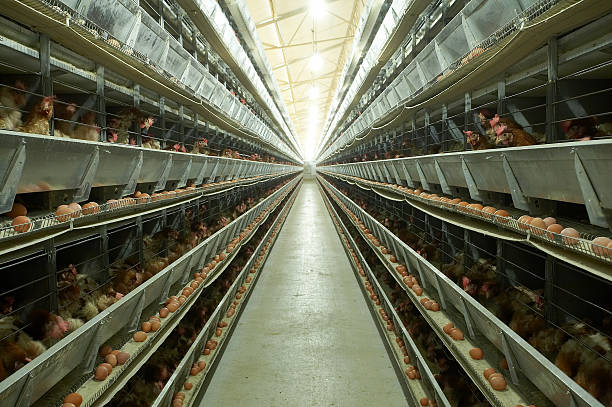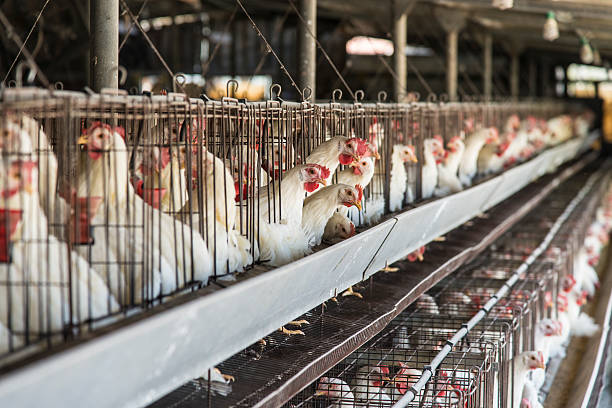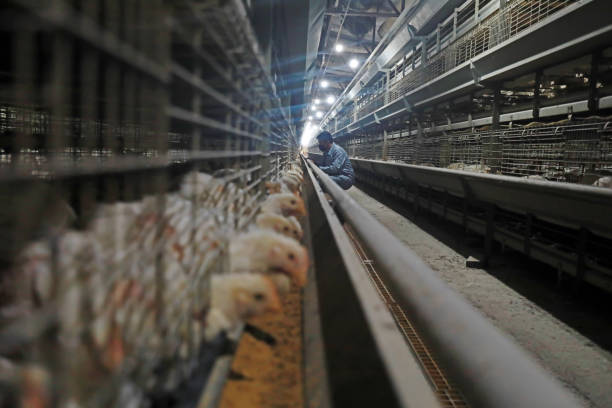
20,000 Bird Battery Cage System: Maximize Your Poultry Farm’s Potential in Africa
20,000 Bird Battery Cage System: Maximize Your Poultry Farm’s Potential in Africa
For poultry farmers in Africa looking to scale up their operations and boost egg production, a 20,000-bird battery cage system presents a compelling opportunity. This comprehensive guide delves into the intricacies of such a system, focusing on its design, benefits, implementation, and long-term impact on poultry farming in the African context. We’ll explore the practical aspects, from selecting the right equipment to managing the flock, ensuring that your investment yields maximum returns while promoting poultry welfare.
Understanding the Battery Cage System: A Modern Poultry Solution
The battery cage system is a housing method designed to maximize space and streamline the management of large flocks of laying hens. In this system, hens are housed in individual or small group cages arranged in rows and tiers, creating a “battery” effect. This controlled environment offers distinct advantages over traditional free-range or deep litter systems, especially when dealing with a large number of birds.
In a 20,000-bird battery cage system, the scale of operation requires careful planning and execution. The system’s overall design, including the cage dimensions, feeding and watering mechanisms, and waste management, needs to be optimized to ensure the health, comfort, and productivity of the flock.
Key Benefits of a 20,000-Bird Battery Cage System

Increased Egg Production: Battery cage systems allow for optimized space utilization and controlled environmental conditions, leading to a significant increase in egg production compared to other methods. Hens are less susceptible to diseases and predators, reducing mortality rates and boosting overall flock health.
Improved Feed Conversion Ratio: With individual or small group housing, it’s easier to monitor feed intake and minimize wastage. This leads to a better feed conversion ratio, meaning you get more eggs for every kilogram of feed consumed, significantly cutting down on costs over time.
Efficient Space Utilization: Battery cages maximize the number of birds that can be housed in a given area. This is particularly beneficial in regions where land is scarce or expensive, allowing for intensive poultry farming without requiring vast expanses of land.
Reduced Disease Risk: The controlled environment of battery cage systems helps to minimize the spread of diseases. With proper ventilation, sanitation, and biosecurity measures, the risk of outbreaks is significantly reduced, ensuring a healthier and more productive flock.
Simplified Waste Management: The design of battery cage systems facilitates efficient waste management. Manure collection and removal are streamlined, reducing labor costs and minimizing environmental pollution. This is crucial for maintaining a clean and hygienic farm environment
Enhanced Monitoring and Management: Battery cages allow for easier monitoring of individual hens’ health and productivity. Farmers can quickly identify and address any issues, such as illness or reduced egg production, ensuring that the flock is well-managed.
Why Choose Battery Cages for Africa?
Africa’s poultry industry is experiencing rapid growth, driven by increasing demand for eggs and poultry meat. However, many poultry farmers face challenges such as limited access to land, high feed costs, and disease outbreaks. Battery cage systems offer a solution to these challenges, providing a more efficient and sustainable way to produce eggs.
Specifically, in the African context, where land resources are often limited and environmental conditions can be harsh, battery cage systems offer a practical and effective solution. The controlled environment of the cages helps to protect hens from extreme temperatures, predators, and diseases, ensuring a more consistent and reliable egg production.
Designing Your 20,000-Bird Battery Cage System: Key Considerations
Before investing in a 20,000-bird battery cage system, it’s essential to carefully consider several factors to ensure that the system is tailored to your specific needs and conditions.
Cage Design and Dimensions: Choose cages that are designed to provide adequate space and comfort for the hens. Consider the size of the birds, the stocking density, and the availability of feed and water. Cages should be made of durable, corrosion-resistant materials to withstand the rigors of the farm environment.
Ventilation System: Proper ventilation is crucial for maintaining a healthy environment inside the poultry house. The ventilation system should be designed to remove excess heat, moisture, and ammonia from the air, ensuring that the hens have access to fresh, clean air.
Feeding and Watering System: Select a feeding and watering system that is efficient, reliable, and easy to maintain. Automatic feeding systems can help to reduce labor costs and ensure that the hens receive a consistent supply of feed. Nipple drinkers provide a clean and hygienic source of water, minimizing the risk of contamination.
Manure Management System: Choose a manure management system that is effective, environmentally friendly, and cost-effective. Options include belt-removal systems, deep litter systems, and composting systems. The choice will depend on factors such as climate, available resources, and environmental regulations.
Lighting System: Install a lighting system that provides adequate illumination for the hens. Proper lighting is essential for stimulating egg production and maintaining the hens’ overall health and well-being. LED lights are a popular choice due to their energy efficiency and long lifespan.
Biosecurity Measures: Implement strict biosecurity measures to prevent the introduction and spread of diseases. This includes controlling access to the farm, disinfecting equipment and vehicles, and implementing a vaccination program.
Selecting the Right Equipment and Suppliers
Choosing the right equipment and suppliers is crucial for the success of your 20,000-bird battery cage system. Look for suppliers with a proven track record of providing high-quality, durable, and reliable equipment.
Consider the following factors when selecting equipment and suppliers:
Quality of Materials: Ensure that the equipment is made of high-quality materials that are resistant to corrosion and wear. This will help to ensure that the equipment lasts for many years, providing a good return on investment.
Reliability: Choose equipment that is known for its reliability and ease of maintenance. This will help to minimize downtime and reduce maintenance costs.
Energy Efficiency: Select equipment that is energy efficient to help reduce operating costs. This is particularly important for lighting and ventilation systems.
Technical Support: Choose a supplier that provides excellent technical support and after-sales service. This will ensure that you have access to expert advice and assistance when you need it.
Cost-Effectiveness: Consider the total cost of ownership, including the initial purchase price, operating costs, and maintenance costs. Choose equipment that provides the best value for money.

Managing Your 20,000-Bird Flock: Best Practices
Effective management is crucial for maximizing the productivity and profitability of your 20,000-bird battery cage system. Here are some best practices to follow:
Feeding and Nutrition: Provide the hens with a balanced diet that meets their nutritional needs. Monitor feed intake and adjust the diet as needed to ensure optimal egg production.
Water Management: Ensure that the hens have access to a constant supply of clean, fresh water. Monitor water consumption and maintain the watering system to prevent leaks and contamination.
Ventilation Management: Maintain proper ventilation to remove excess heat, moisture, and ammonia from the poultry house. Adjust the ventilation system as needed to maintain a comfortable environment for the hens.
Health Management: Implement a comprehensive health management program to prevent and control diseases. This includes vaccination, parasite control, and biosecurity measures.
Egg Collection: Collect eggs regularly to minimize breakage and contamination. Store eggs properly to maintain their quality and freshness.
Waste Management: Manage manure effectively to minimize environmental pollution and odor. Dispose of manure properly in accordance with local regulations.
Record Keeping: Maintain accurate records of egg production, feed consumption, water consumption, mortality, and other key performance indicators. This will help you to identify trends and make informed decisions.

Lighting Management: Adhere to a strict lighting schedule to stimulate egg production. Generally, 16 hours of light and 8 hours of darkness are required for optimal egg laying.
Labor Management: Train your staff properly and provide them with the resources they need to manage the flock effectively. Efficient labor management is essential for maximizing productivity and minimizing costs.
Challenges and Solutions in the African Context
Poultry farmers in Africa face unique challenges that can impact the success of a 20,000-bird battery cage system. Some of these challenges include:
High Feed Costs: Feed costs can be a significant expense for poultry farmers in Africa. To reduce feed costs, consider sourcing feed locally or growing your own feed ingredients. Also, focus on improving feed conversion ratios through proper nutrition and management.
Disease Outbreaks: Disease outbreaks can devastate poultry flocks. To minimize the risk of outbreaks, implement strict biosecurity measures, vaccinate your birds regularly, and maintain a clean and hygienic farm environment.
Limited Access to Finance: Access to finance can be a barrier for many poultry farmers in Africa. Explore various financing options, such as loans, grants, and partnerships, to secure the capital you need to invest in a battery cage system.
Unreliable Power Supply: Unreliable power supply can disrupt operations and lead to losses. Invest in a backup generator or solar power system to ensure a continuous supply of electricity.
Market Volatility: Market volatility can affect the profitability of poultry farming. Diversify your products and markets to reduce your exposure to risk. Also, consider joining a cooperative or producer group to strengthen your negotiating power.
The Long-Term Impact of Battery Cage Systems on Poultry Farming in Africa
Battery cage systems have the potential to transform poultry farming in Africa, providing a more efficient, sustainable, and profitable way to produce eggs. By increasing egg production, improving feed conversion ratios, and reducing disease risk, battery cage systems can help to meet the growing demand for eggs and poultry meat, while also improving the livelihoods of poultry farmers.
However, it is important to consider the ethical and environmental implications of battery cage systems. While battery cage systems offer several advantages, it is important to prioritize poultry welfare and environmental sustainability. Implement best practices in animal husbandry and waste management to minimize the negative impacts of battery cage systems. Strive for a balance between productivity and ethical considerations to ensure a sustainable future for poultry farming in Africa.
By carefully planning and managing your 20,000-bird battery cage system, you can maximize your poultry farm’s potential and contribute to the growth of the poultry industry in Africa. Remember, success requires a commitment to quality, efficiency, and sustainability. By adopting best practices and embracing innovation, you can achieve your goals and make a positive impact on the livelihoods of your community.
